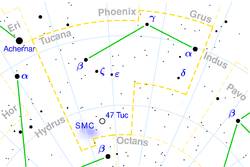Zeta Tucanae
| Observation data Epoch J2000 Equinox J2000 | |
|---|---|
| Constellation | Tucana |
| Right ascension | 00h 20m 04.25995s[1] |
| Declination | −64° 52′ 29.2549″[1] |
| Apparent magnitude (V) | 4.23 |
| Characteristics | |
| Spectral type | F9.5 V[2] |
| U−B color index | 0.02[3] |
| B−V color index | 0.58[3] |
| Variable type | None[4] |
| Absolute magnitude (MV) | 4.67[6] |
| Details | |
Gyr | |
LTT 167[14] | |
| Database references | |
| SIMBAD | data |
Zeta Tucanae,
light years from Earth.[1] This is one of the least variable stars observed during the Hipparcos mission.[4][15]
The composition and mass of this star are very similar to the Sun, with a slightly lower mass and an estimated age of three billion years. The solar-like qualities make it a target of interest for investigating the possible existence of a life-bearing planet.[15]
Based upon an excess emission of infrared radiation at 70 micrometres, this system is believed to have a debris disk. The disk is orbiting the star at a minimum radius of 2.3 astronomical units. It is radiating with a maximum temperature of 218 K.[12] As of 2009, no planet has been discovered in orbit around this star.[16]
The components of this star's
space velocity
are U = −60, V = −4 and W = −38 km/s. These correspond to the velocity toward the Galactic Center, the velocity along
the direction of galactic rotation, and the velocity toward the north galactic pole, respectively.[17] It is orbiting through the galaxy at a mean distance of 8.4 kpc from the Galactic Center and with an orbital eccentricity of 0.16.[15]
See also
References
- ^ .
- S2CID 119476992
- ^ Bibcode:1966CoLPL...4...99J.
- ^ .
- Bibcode:1967IAUS...30...57E.
- Bibcode:1999A&A...343..222E
- ^ S2CID 119347084.
- ^ S2CID 118565025
- ^ S2CID 16775366.
- .
- S2CID 18041021.
- ^ S2CID 54940779.
- S2CID 27151456.
- ^ "LHS 5 -- High proper-motion Star". SIMBAD. Centre de Données astronomiques de Strasbourg. Retrieved 2010-05-21.
- ^ S2CID 119459291.
- S2CID 16636256.
- ^ Woolley, Richard van der Riet (1970). "Catalogue of Stars within 25 Parsecs of the Sun". Royal Observatory Annals. 5. Herstmonceux, Royal Greenwich Observatory. Retrieved 2009-09-02.
External links
- Zeta Tucanae at SolStation

